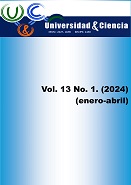Evaluation of Cannabis sativa L, oil for the management of osteoarticular pain in canines
DOI:
https://doi.org/10.5281/zenodo.10511434Keywords:
Analgesia, Cannabis, Cannabinoid system, Domestic canines, OsteoarticularAbstract
Advances in veterinary medicine and the implementation of newtherapies incorporated into domestic canines and felines have made itpossible to improve the quality of life of pets, using cannabis oilextract, which has become an analgesic alternative, specifically incanines from middle to advanced age, with osteoarticular pain,generating a reduction in the normal activity of pets, observinglameness, stiffness, limitation of movement, loss of appetite and muscledegeneration. For this reason, the objective of the research was toevaluate the analgesic effect of the Cannabis sativa oil extract for themanagement of osteoarticular pain in canine patients. The research wascarried out at the Little Pet Veterinary Clinic, located in the provinceof Imbabura, in the Sierra region of Ecuador, in the canton of Otavalo,two doses (2mg/kg, 5mg/kg) of cannabis oil extract were evaluated,applied sublingually, where 20 canines were used, the parametersanalyzed were: Glasgow pain scale, blood count, blood chemistry aCompletely Randomized Design (DCA) was established, the statisticalanalysis included a comparison of means by means of frequencies inInfoStat version 1613-2013 and p value test. The dose of 5mg / kggenerated the best results, observing a significant reduction in theperception of pain and inflammation, and increased mobility, showing themost active canines improving their quality of life, due to itsanalgesic, immunomodulatory and antiinflammatory effect that it has.
Downloads
References
BARTNER, L. … [et al.] (2018). Pharmacokinetics of cannabidiol administered by 3 delivery methods at 2 different dosages to healthy dogs. Canadian Journal of Veterinary Research. Vol. 82, No. 1, pp. 178-183.
BELSHAW, Z. y YEATES, J. (2018). Assessment of quality of life and chronic pain in dogs. Veterinary Journal. Vol. 239, No. 1, pp. 59-64.
CABRERA, A. (2021). Índice neutrófilo-linfocito como factor de riesgo de mortalidad en pacientes con Covid-19 del servicio de medicina interna en el Hospital General de Jilotepec en el periodo del 1º julio 2020 al 31 octubre 2020. Universidad Autónoma del Estado de México.
COSTA, B. (2007). The non-psychoactive cannabis constituent cannabidiol is an orally effective therapeutic agent in rat chronic inflammatory and neurophatic pain. European Journal of Pharmacology. Vol. 556, No. 1, pp. 75-83.
DE GREGORIO, D. … [et al.] (2019). Cannabidiol modulates serotonergic transmission and reverses both allodynia and anxiety-like behavior in a model of neuropathic. Pain. Vol. 160, No. 1, pp. 136-150. Disponible en: https://doi.org/10.1097/j.pain.0000000000001386. Visitado: 24 de mayo de 2023.
EPSTEIN, M. … [et al.] (2015). AAHAI.AAFP pain management guidelines for dogs and cats. Journal of the American Animal Hospital Association. Vol. 51, No. 1, pp. 67-84.
GAMBLE, L. … [et al.] (2018). Pharmacokinetics, safety, and clinical efficacy of cannabidiol treatment in osteoarthritic dogs. Frontiers. Vol. 5, No. 1, pp. 1-9. Disponible en: https://doi.org/10.3389/fvets.2018.00165. Visitado: 24 de mayo de 2023.
HARTSEL, J. … [et al.] (1970). Cannabis in veterinary medicine: Cannabinoid therapies for animals. Springer International Publishing. Disponible en: https://doi.org/10.1007/978-3-030-04624-810. Visitado: 24 de mayo de 2023.
HERMANN, D. … [et al.] (2007). Pérdida de N-acetilaspartato/creatina total (NAA/tCr) de la corteza prefrontal dorsolateral en consumidores masculinos de cannabis recreativo. Psiquiatría Biológica. Vol. 61, No. 11, pp. 1281-1289. Disponible en: http://dx.doi.org/10.1016/j.biopsych.2006.08.027. Visitado: 24 de mayo de 2023.
KRÖGER, E. y DIONNE, C. (2021). Medical Cannabis for Chronic pain. British Medical Journal Publishing Group. Vol. 374, No. 1, pp. 1942. Disponible en: https://doi.org/10.1136/bmj.n1942. Visitado: 24 de mayo de 2023.
KUKANICH, K. … [et al.] (2021). Effects of low-dose meloxicam in cats with chronic kidney disease. Journal Feline Med Surg. Vol. 23, No. 2, pp. 138-148. Disponible en: https://doi.org/10.1177/1098612X20935750. Visitado: 24 de mayo de 2023.
MATHEWS, P. … [et al.] (2014). Guidelines for recognition, assessment and treatment of pain: WSAVA Global F ain Council members and co-authors of this document. Journal of Small Animal Practice. Vol. 55, No. 1, pp. E10-68.
MONDINO, A. … [et al.] (2019). Intoxicación por cannabis en pequeños animales. Veterinaria (Montevideo). Vol. 55, No. 212, pp. 86-95. Disponible en: https://doi.org/10.29155/vet.55.212.7. Visitado: 24 de mayo de 2023.
NICACIO, G. … [et al.] (2019). Toxina botulínica A intraarticular (BoNT/A) para el tratamiento del dolor en perros con osteoartritis secundaria a displasia de cadera: un ensayo clínico controlado aleatorio. Journal of Veterinary Science. Vol. 81, No. 1, pp. 411-417. Disponible en: http://dx.doi.org/10.1292/jvms.18-0506. Visitado: 24 de mayo de 2023.
PELÁEZ, M. … [et al.] (2021). Papel del sistema cannabinoide endógeno en el intestino. Multimed Revista médica. Granma, Vol. 25, No. 2, pp. e2216. Disponible en: https://revmultimed.sld.cu/index.php/mtm/article/view/2216/2101. Visitado: 24 de mayo de 2023.
SALGADO, S. (2017). Uso de cannabinoides para el tratamiento de epilepsia idiopática en caninos - Reporte de dos casos. En: Congreso de Especialidades Veterinarias. Mendoza, Argentina.
SÁNCHEZ, A. … [et al.] (2019). Cannabinoids CB2 receptors, one new promising drug target for chronic and degenerative pain conditions in equine veterinary patients. Journal Equine Vet Sci. Vol. 81, No. 1, pp. 102880. Disponible en: https://doi.org/10.1016/j.jevs.2019.102880. Visitado: 24 de mayo de 2023.
SILVER, R. (2019). The Endocannabinoid System of Animals. Animals (Basel). Vol. 9, No. 9, pp. 686. Disponible en: https://doi.org/10.3390/ani9090686. Visitado: 24 de mayo de 2023.
STANZANI, A. … [et al.] (2020). Localization of cannabinoid and cannabinoid related receptors in the cat gastrointestinal tract - histochemistry and Cell Biology. Histochem Cell Biol. Vol. 153, No. 1, pp. 339-356. Disponible en: https://doi.org/10.1007/s00418-020-01854-0. Visitado: 24 de mayo de 2023.
Downloads
Published
How to Cite
Issue
Section
License
Copyright (c) 2023 Universidad & ciencia

This work is licensed under a Creative Commons Attribution-NonCommercial-ShareAlike 4.0 International License.





















